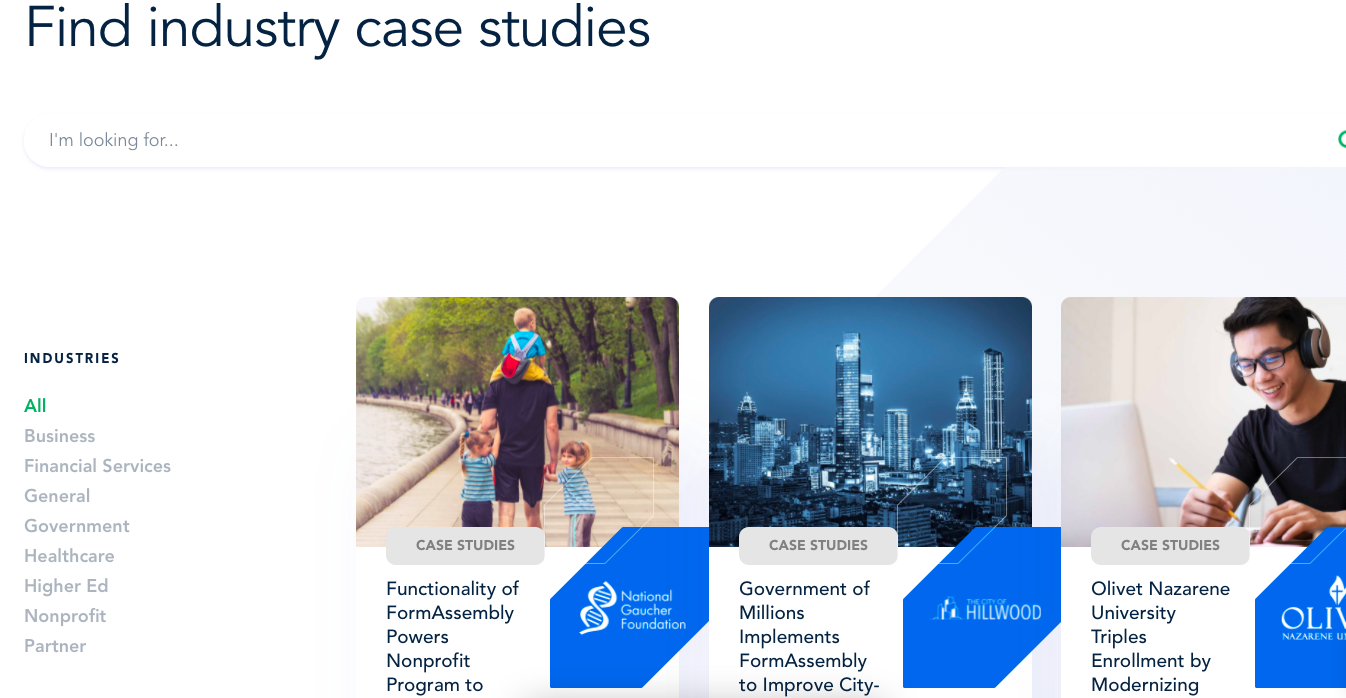In a business-to-business (B2B) model, proving the effectiveness of your product or service is extremely valuable. Not only do you need to illustrate that your offer delivers tangible results, but the entire case study process should be designed to help foster stronger relationships with your customer community.
Case studies can be prominent throughout each phase of the customer acquisition process. From Awareness, to Consideration, to Decision, the information you publish in case studies has the potential to influence buyer behavior and set your company up for further success.
In this post, we’ll cover all you need to know about creating effective and powerful B2B case studies from our own experience. Keep reading for a proven six-step process for studies that help your organization stand out from the competition.
Why do B2B companies need a case study strategy?
A B2B case study is more than a standard blog post. While case studies should align with your comprehensive content marketing strategy, you should also develop a dedicated plan that focuses specifically on case study creation.
In most scenarios, a B2B case study tells the success story of a customer that has experienced tangible benefits from investing in your product or service.
A well-written, strongly supported case study also accomplishes the following important goals:
- Builds brand credibility – Potential and current customers should see the value and longevity of your brand and its place in a competitive market.
- Highlights data-backed statistics – Case studies are an additional way to gather important metrics and results from your active user base. You may discover tangible numbers related to the amount of money saved, number of people impacted, or number of customer conversions.
- Offers insights for current customers – Case studies also provide a wealth of inspiration for current customers. This is particularly true when established users discover new and innovative use cases. The results are mutually beneficial.
Characteristics of a strong B2B case study
The best case studies not only illuminate the importance of your service or product, they also tell a story. Effective B2B case studies should take readers on a journey from initial pain point to eventual solution. The narrative should be prominent throughout and tie everything together.
Other important characteristics to include in your case studies include:
- Strong titles that highlight the results you want readers and prospects to see
- Well-written summaries that adequately introduce the customer and your business (since not every reader will be familiar with your organization)
- Engaging and genuine quotes, questions, and other important details
- The “before and after” state the customer experienced when using your service (i.e., why were they frustrated previously, but satisfied now?)
How to create an effective and informative case study
Case studies can play an extremely important role in your sales, marketing, and brand awareness efforts. But don’t be too intimidated by the process. By establishing a predictable system, you can easily generate highly effective, conversion-ready B2B case studies.
Follow the six steps below to create expertly written case studies that elevate your customer marketing efforts.
Step 1: Get to know your highly engaged customers
Become familiar with your active customers. For the purpose of creating case studies, it’s also helpful to know which industries your customers serve.
Keep in mind that it’s not only the “big name” customers that experience sustainable results. Many small-scale businesses and organizations may be easier to reach when you need to collaborate for a case study. Additionally, the results that smaller businesses experience may be even more impactful, since their resources tend to be more limited.
If you don’t have a way to regularly keep a pulse on your customer communication, try something like the FormAssembly VIP Program. This group is designed to engage active users and provide an outlet for them to share questions, successes, and results and has proven to be very helpful for our own team.
Step 2: Conduct purposeful research and interviews
Once you have a contact at an organization, set up a time for an official interview. If possible, try to send the interviewee a list of thoughtful questions ahead of time so that they can better prepare and know what to expect.
At the start of your meeting, explain the full case study process. This allows the customer to better understand how you plan to use the information that they provide. It’s also a chance to address any objections or clarify expectations.
Throughout the interview, keep things conversational and relaxed. Ask your customer questions about their experience prior to using your product, and request more information about the results they experienced once their journey began. By recording the conversation and taking detailed notes, you’ll be better equipped to remember usable quotes and key metrics.
Step 3: Identify the pain point and success
As you interview and compose your written case study, remember to highlight the “before and after” state. You might ask questions such as:
- What frustrations did your team experience before implementing this solution?
- What were the greatest challenges you felt during the course of normal operations?
- How did implementing this new solution relieve a burden or provide better results?
- How has the work culture changed for the better since adopting this solution?
The “pain point and success” arc is where your storytelling skills come into focus. Add details that allow other customers to see themselves in a similar position.
Step 4: Craft compelling content
Compelling content is the result of several powerful sections that work together to form a complete narrative.
If one of your case study sections is lacking the information that you’d ideally like to include—don’t stress. Compensate for gaps by including strong testimonials, descriptions, numbers, and other tangible details.
To make your case studies more searchable, optimize them for SEO. This includes finding relevant keywords, outlining your study with on-page headers, and adding direct calls to action.
Step 5: Use high-impact metrics, visuals, and testimonials
Although the written content of your study is most important, interactive elements can help tell the story while keeping readers engaged. To make your case studies stand out, consider incorporating the following elements.
- Expandable text or menu boxes
- Product screenshots (non-confidential)
- Counters and other visual elements to showcase metrics or numbers
- Relevant photos and imagery
- Headshots and brand logos
Step 6: Share and promote your content
Before you publish your study, it’s always a good idea to send it back to the original customer. This gives the organization a chance to proof the article and sign off on certain details that may be subject to marketing or legal approval.
Once you have the final thumbs up, publish your study and encourage others on your team to spread the word. You can also promote the study on social media platforms (like LinkedIn, Twitter, and Facebook) or include it in your content email blasts. When you share, use trackable links so that you can gather data on where case study traffic is coming from.
As a bonus step, consider repurposing your case studies into other types of information products. For example, you may ask a case study participant to share their experiences on a webinar, or to present their innovative use case in a workshop or training session for other customers.
How to leverage your published studies for maximum impact
Remember, case studies provide nearly endless potential for your content marketing efforts. Since every customer story is unique, you have multiple opportunities to capture the special selling points that make your product or service different.
Never underestimate the power of case studies to the entire customer journey. Research shows that up to 80% of customers read and search for relevant case studies as part of their buying journey, which underscores how important it is to devote time and resources to the development of case studies.
Once you have a library of strong B2B case studies, put them to work! Share them with other departments, equip sales team members with how to locate studies, and position them prominently on your website for maximum visibility. For example, at FormAssembly, we’ve made our own case study library searchable and categorized it by industry.

Wrapping up
Strong B2B case studies have the potential to elevate your existing content marketing strategy from good to great. By spotlighting your company’s benefits through proven customer stories, you can produce strong pieces that are easy to use, share, and distribute.
Regardless of whether you have plenty of published studies or want to establish a brand new case study program at your company, apply the tips in this post to create the most well-rounded customer success stories. Below, check out FormAssembly’s extensive case study library for examples of these best practices in action.
